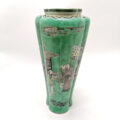by Sally Gregson.
IN many people’s minds gladioli will forever be associated with the gloriously daft Dame Edna Everage.
Every performance ended with sheaves of the flowers thrown individually onto the audience amid shrieks of laughter. It’s probably not the best form of publicity, and perhaps has contributed to the lessening popularity of growing gladioli.
However, there are different species of glads out there, just waiting to grow in a sunny patch in everyone’s gardens. And early spring is just the right time to plant the corms. Place them on a bed of sharp sand in fertile but well-drained soil at a depth of 10-16cm deep. The sand will drain the excess moisture away from the base of each corm.
They flower best in full sun. Here in the south of England there is no need to lift the species gladioli for winter if they are grown in well-drained soil. Some forms have very different flowers: G. papilio resembles Dame Edna’s glads the least. It bears utterly beautiful flowers with hooded buff-purple and green petals with feathered purple and gold markings inside. They do need a warm spot where they enjoy a modicum of moisture without becoming waterlogged. But. They can be quite shy-flowering and so have not become as popular as perhaps they should.
Some years ago, at the beautiful garden at Hadspen House, long before The Newt was in existence, the late Nori and Sandra Pope selected a totally novel bi-specific cross between G. papilio and a hybrid glad and called it G. ‘Ruby’. It is now thought more likely to have G. ecklonii in its blood. Gladiolus ‘Ruby’ has rich, velvety crimson, hooded flowers with a dark throat. And it flowers. And, unsurprisingly, is very sought-after.
Recently Avon Bulbs has raised and named seedlings of G. ‘Ruby’. After ten years’ trialling they have selected G. ‘Thunder’ with deep plum flowers. They call it ‘a gorgeous discovery’. It’s bound to be another sensation.










Leave a Reply